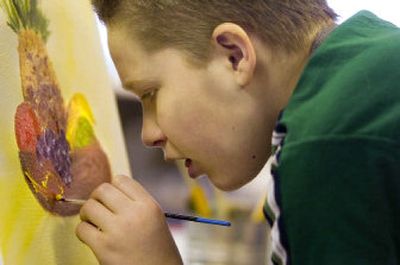Artistic Inspiration

David McBee bends his head close to the canvas, his face contorted in concentration. His fingers deftly handle the brush and a picture quickly evolves from his sure strokes. A lonely cabin giving winter shelter to kangaroos or ducks serenely skating on a frozen pond appear where once there was only a field of white.
A blond crew cut, blue-gray eyes and a black T-shirt lend him the look of any other boy in his hometown of Loon Lake. While painting, however, two things set him apart: the art instructor supporting his arm and the sheer genius of his work.
Thirteen-year-old David has severe Asperger’s syndrome, has not and may never learn to read or count change, and has a hard time communicating with anyone outside his immediate family. Yet when he picks up a paintbrush, a different kind of intelligence shines though and his life is elevated to a new plateau. In a few short months, he is painting at a level few adults ever reach. He is calmer, happier and more productive than ever before.
“This is a boy who used to climb under his desk and hide,” David’s mother, Deanne McBee said. “He’s so much happier now that he has this.”
McBee first noticed something different about David when he was little more than a toddler. By age 2, she could see that her first-born had speech and physical delays. For several years, the specialists she brought him to attributed David’s problems to McBee’s marital situation. “No one wanted to say he was autistic,” she said. “Because he could speak, they finally came out with Asperger’s.”
Children with Asperger’s, a milder form of autism, often suffer from severe social impairment. They commonly avoid eye contact, have trouble communicating and are physically clumsy.
Years of sensory integration, and speech and physical therapy brought David’s motor and speech skills to that of a very shy 6-year-old. He attended Loon Lake Elementary School for nine years yet, even with coaching and practice, could not make the transition to junior high. The stress he underwent trying to adjust to a new environment would bring on severe panic attacks.
As he grew older, he became increasingly aware that there was something different about him, and it began to bother him. The stress was inducing asthma attacks and making him physically ill.
“When school ended, I saw how much my David came back,” McBee said, referring to how much calmer he seemed over the summer. “The stress was just too much.” She decided to homeschool him.
Knowing social interaction was still very important for him, McBee signed David up for Home Link, a program designed to allow home-schooled students to participate in classes such as art, computer and sports.
David had always exhibited remarkable art talent. At age 5, he was producing complex drawings at a 10- to 12-year-old level. His treasured portfolio contains airplanes with detailed cutaways of the interior, dinosaurs looking for dinner and complex mazes and games.
His art teacher, Sue Christie, a volunteer at Loon Lake Elementary – the school can’t afford its own art program – had been trying to get David to paint for some time, but he simply refused. He loved drawing and that was good enough.
Finally, last fall, David began painting rocks he picked up around his rural neighborhood. Christie continued to urge him to try painting on a canvas, and one day he decided he was ready.
The colors and form of his first painting, a 3- by 4-foot rendition of brightly colored parrots, leapt off the page and immediately captured the attention of those around him. That turned out to be his only tempera painting. Christie switched him to oil paint the next week and he took off. “I truly didn’t think he’d take it up as soon as he did, but he went right for it,” Christie said.
He started painting on canvas in the beginning of October and by the end of that month he was producing one painting every Wednesday morning in the 45 minutes allotted to his class. Every class begins with a discussion between David and Christie to plot his day’s efforts.
Once he is ready to begin, Christie often must support his arm while he works. David’s medication combined with his condition frequently causes severe and uncontrollable tremors. Christie gently cups her hand beneath his elbow or wrist when he’s transferring what he sees in his head onto the canvas.
“It’s fascinating to work with David, just incredible,” Christie said. “You never know what he will come up with.”
Contrary to his drawings, which often depict technical details and man-made artifacts, David favors painting nature scenes, particularly snow-covered lakes, forests and mountains.
“He sees something and it’s inside his head and it’s different from what we see,” McBee said. “He’s able to express himself where he can’t describe it in words.”
His first oil painting depicts a man braving rapids to reach a blueberry bush on the far bank. In another, a lakeside is home to a large toad named Trevor. Still others depict skiers racing down the mountain at 49 Degrees North and dolphins splashing through the surf.
“When you have a child like David, it’s sometimes hard to find the good. With all the therapy and so much he can’t do, it can be draining and sad. It’s good to hear and see there’s light at the end of the tunnel,” McBee said. “It’s good to see there’s some hope.
“It’s good for him to have something so positive.”